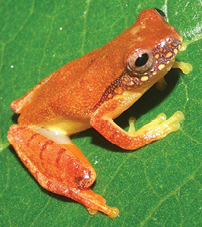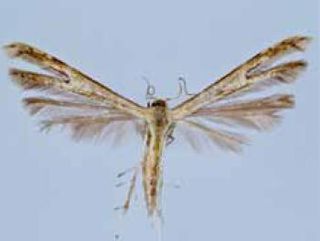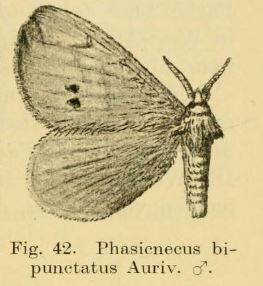
Alburnoides bipunctatus, known vernacularly as the schneider, spirlin, bleak, riffle minnow, and others, is a species of small freshwater fish in the Cyprinidae family. It is found in Afghanistan, Armenia, Austria, Azerbaijan, Belarus, Belgium, Bulgaria, Czech Republic, Croatia, Estonia, France, Georgia, Germany, Hungary, Iran, Latvia, Lithuania, Moldova, the Netherlands, North Macedonia, Poland, Romania, Russia, Serbia, Slovakia, Switzerland, Turkey, Ukraine, and Uzbekistan. This fish inhabits rivers with very calm waters, and it eats dead insects and insect larvae, diatoms, and crustaceans. It reproduces during April to June.

Dendropsophus bipunctatus is a species of frog in the family Hylidae. It is endemic to Brazil. Its natural habitats are subtropical or tropical moist lowland forests, subtropical or tropical moist montane forests, subtropical or tropical moist shrubland, subtropical or tropical seasonally wet or flooded lowland grassland, freshwater marshes, intermittent freshwater marshes, pastureland, and ponds.
Pristimantis bipunctatus is a species of frogs in the family Craugastoridae.

Rhacophorus bipunctatus is a frog species in the moss frog family (Rhacophoridae) found from eastern India into Southeast Asia, possibly to southeastern China and south to Malaysia. Due to the identification problems surrounding this species, the eastern and southern limits of its range remain undetermined; all that is known is that the species certainly occurs in the border region of India, Bangladesh, China and Myanmar; its range might extend south to Malaysia, as similar frogs have been reported from Pahang.

Rhacophorus rhodopus is a species of frog in the moss frog family (Rhacophoridae). It occurs in southeastern Asia, from India to southern China, and south to Malaysia. Previously unknown from Laos, it has now been found in Phongsali Province and at Luang Prabang. Its taxonomy is disputed.
Tetrachaetus is a genus of flies in the family Dolichopodidae, found in New Zealand. The genus was originally named by Octave Parent in 1933. However, as the genus was not designated a type species, this name was unavailable until 1989, when Daniel J. Bickel and C. E. Dyte designated Tetrachaetus bipunctatus as the type species.

The Northwestern Himalayan alpine shrub and meadows is a montane grasslands and shrublands ecoregion of the elevations of the northwestern Himalaya of China, India, and Pakistan.

Adaina is a genus of moth in the family Pterophoridae.

Adaina bipunctatus is a moth of the family Pterophoridae. It is found in the United States, including Florida and Mississippi. It has also been recorded from Trinidad, the West Indies, Brazil and Ecuador.

The riffle minnow is a North American species of cyprinid freshwater fish. It inhabits riffles in warm streams of medium to large size, in the states of Alabama, Georgia, and Tennessee, above the Fall Line. Long and slender, it averages about 3.5 inches (8.9 cm) in length. The riffle minnow is olive on top, and white below.

Charaxes bipunctatus, the two-spot blue charaxes, is a butterfly in the family Nymphalidae. It is found in Ivory Coast, Ghana, Nigeria, Cameroon, Gabon, the Republic of the Congo, the Democratic Republic of the Congo, the Central African Republic, Uganda, Sudan, Kenya and Tanzania. The habitat consists of lowland evergreen forests and sub-montane forests at altitudes between 1,200 and 1,500 meters.

Stenoglene bipunctatus is a moth of the family Eupterotidae. It can be found in the Republic of the Congo and in Malawi.
Diadelioides is a genus of longhorn beetles of the subfamily Lamiinae, containing the following species:
Diadelioides bipunctatus is a species of beetle in the family Cerambycidae. It was described by Breuning in 1940.
Blepephaeus bipunctatus is a species of beetle in the family Cerambycidae. It was described by Stephan von Breuning and de Jong in 1941. It is known from Sumatra.
Pelargoderus bipunctatus is a species of beetle in the family Cerambycidae. It was described by Dalman in 1815. It is known from Java.
Oxybelus bipunctatus is a species of square-headed wasp in the family Crabronidae. It is found in Africa, Europe & Northern Asia, and North America.

Autochton bipunctatus, also known by the vernacular names Gmelin's banded skipper, two-spotted banded skipper, and twin-spot banded skipper, is a butterfly species in the family Hesperiidae.











